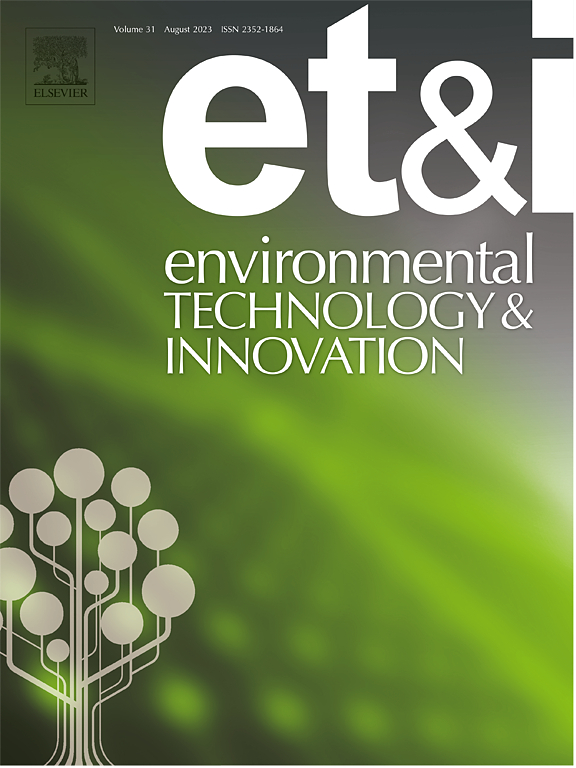处理酸性矿山废水的可持续关系:生物碱基质如何影响酸性中和和重金属去除?
IF 6.7
2区 环境科学与生态学
Q1 BIOTECHNOLOGY & APPLIED MICROBIOLOGY
引用次数: 0
摘要
酸性矿井水具有酸度高、重金属含量高的特点,对生态系统构成了持续的威胁。传统的中和剂(NaOH、Na2CO3、Ca(OH)2)能有效提高pH值,但产生的污泥量大,运行成本高。在这里,从土壤和城市活性污泥中富集的三个脲酶阳性微生物群落与尿素一起培养,以生产生物碱基质(bama /B/C,最终pH为9.3)。BAM中含有丰富的-CONH2、-NH2、-OH和-COOH等能够螯合金属离子的基团,这表明碱液缓冲是由配体介导的金属螯合所补充的。当每种BAM以3:10 体积比与AMD混合时,出水pH稳定在7,对Al, Fe, Cr, Cd的去除率达到~ 100 %;>; 90 % As, V, Co, Ni;79-80 % Cu;Mn为60 - 62 %。地球化学分析表明,Fe/Al羟基硫酸盐和有机金属配合物是主要沉淀。全成本比较表明,bama降低了处理费用至35.5元/ m3,比NaOH低12% %,比Ca(OH)2低26% %,同时减少了污泥的产生。将BAM与硫酸盐还原细菌系统耦合可以提高Mn和SO42的去除率。总体而言,BAM通过将碱性缓冲与有机络合结合,为AMD中和提供了一种经济且环境可持续的替代方案。本文章由计算机程序翻译,如有差异,请以英文原文为准。
Sustainable nexus for treating acid mine drainage: How does bio-alkali matrix impact acidity neutralization and heavy metal removal?
Acid mine drainage (AMD), characterized by high acidity and elevated concentrations of heavy metals, poses a persistent threat to ecological systems. Conventional neutralizers (NaOH, Na2CO3, Ca(OH)2) raise pH effectively but generate large sludge volumes and incur high operating costs. Here, three urease-positive microbial consortia, enriched from soil and municipal activated sludge, were cultivated with urea to produce bio-alkali matrices (BAM-A/B/C, final pH 9.3). Abundant –CONH2, –NH2, –OH, and –COOH groups capable of chelating metal ions were found in BAM, suggesting alkaline buffering is complemented by ligand-mediated metal sequestration. When each BAM was mixed with AMD at a 3:10 vol ratio, the effluent pH stabilized at 7 and removal efficiencies reached ∼100 % for Al, Fe, Cr, Cd; > 90 % for As, V, Co, Ni; 79–80 % for Cu; and 60 – 62 % for Mn. Geochemical analysis identified Fe/Al hydroxysulfates and organo-metal complexes as dominant precipitates. A full cost comparison showed BAM-A lowered treatment expenses to 35.5 RMB per m3, which is 12 % below NaOH and 26 % below Ca(OH)2, while reducing sludge generation. Coupling BAM with sulfate-reducing bacterial systems is advisable to enhance Mn and SO42- removal. Overall, BAM provides an economical and environmentally sustainable alternative for AMD neutralization by uniting alkaline buffering with organic complexation.
求助全文
通过发布文献求助,成功后即可免费获取论文全文。
去求助
来源期刊

Environmental Technology & Innovation
Environmental Science-General Environmental Science
CiteScore
14.00
自引率
4.20%
发文量
435
审稿时长
74 days
期刊介绍:
Environmental Technology & Innovation adopts a challenge-oriented approach to solutions by integrating natural sciences to promote a sustainable future. The journal aims to foster the creation and development of innovative products, technologies, and ideas that enhance the environment, with impacts across soil, air, water, and food in rural and urban areas.
As a platform for disseminating scientific evidence for environmental protection and sustainable development, the journal emphasizes fundamental science, methodologies, tools, techniques, and policy considerations. It emphasizes the importance of science and technology in environmental benefits, including smarter, cleaner technologies for environmental protection, more efficient resource processing methods, and the evidence supporting their effectiveness.
 求助内容:
求助内容: 应助结果提醒方式:
应助结果提醒方式:


